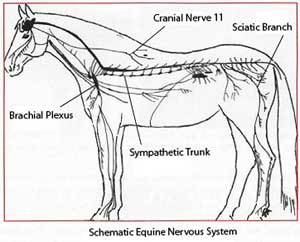
This reflex point is known as Cranial Nerve 11 (CN11). Pinching gullet plates, lungeing girths, vaulting girths, driving harnesses and foregirths will achieve the same result as the stallion’s bite acting upon the muscles in the wither region like a vise grip. Nature has determined three survival mechanism reflexes for CN11: if the mare or the rival horse is bitten here, or if the gullet plate of the saddle pinches the side of the withers here, the nerve signals to the brain that the movement in the upper arm and shoulder blade be blocked. The second signal ensures that the longissimus muscle contracts, dropping the horse’s back (and that the vertebrae fall into each other as in kissing spine syndrome). Thirdly, the pelvis will rotate forward and open as a result of further contraction of the longissimus, opening the area in preparation for mating.
All three of these reactions will result in reflexive immobility for the horse. Read the full here.
~ Jochen Schleese CMS, CSFT, CSE, courtesy of Saddlefit 4 Life
